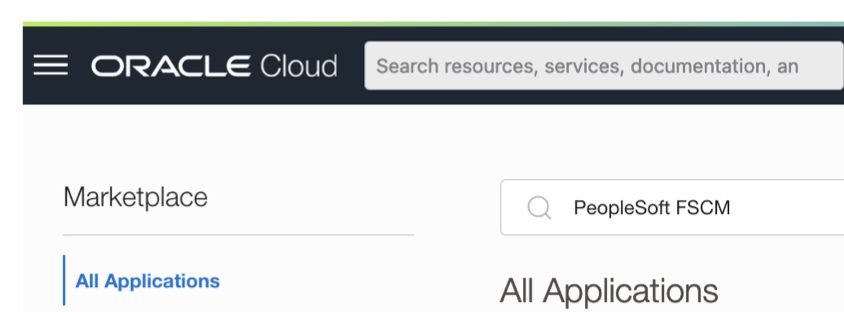In this video we will build a new PeopleSoft Image to check out some of the newer features. We will use OCI to host our image because the PeopleSoft team provides us with images that are ready to build. We just need to provide some passwords and away we go.

OCI Marketplace Images
The OCI Marketplace is where you can find pre-packaged software ready to deploy on OCI. Each new image release, the PeopleSoft team pushes a new build for each application. For this demo, we will use Finance Image 46.
There are a few benefits to the OCI Marketplace-based PeopleSoft Images over other methods.
- No need to download DPK files to a server
- They come with Elasticsearch and Kibana pre-packaged
- They are updated each release and easy to build for developers
- Doesn’t require Cloud Manager or MOS Download rights
There are a few drawbacks to using these images though.
- They don’t support the new VM.Standard Flex shapes
- You need an OCI account and privileges to create a new instance (and virtual cloud network)
Boot Volume
When building a Marketplace-based Image, you must increase the boot volume to at least 200GB. This will ensure there is plenty of space to extract the DPK files and install PeopleSoft.
Generate Passwords
You can enter these by hand – it’s a JSON string – but there are different requirements for each password. You can use the sample JSON below for reference, but let’s take a quick tangent and I’ll show you how I generated my passwords.
The secret is psst
To run psst, you need Python and Git installed:
For Windows you can use Powershell and Chocolatey to install these:
Set-ExecutionPolicy Bypass -Scope Process -Force; [System.Net.ServicePointManager]::SecurityProtocol = [System.Net.ServicePointManager]::SecurityProtocol -bor 3072;
iex ((New-Object System.Net.WebClient).DownloadString('https://community.chocolatey.org/install.ps1'))
choco install python3 -y
choco install git -y
For Linux and macOS:
yum install git -y
yum install python3 -y
The psst tool is hosted on Github and you can clone the code to run it:
git clone https://github.com/psadmin-io/psst.git
cd psst
pip install .
psst secrets generate -oci
{
"connect_pwd": "eu9P3HCj6WwI95vj498JX6Yzjk6VGS",
"access_pwd": "hsRqmDFjyrntMEJ74fMBBwMKi",
"admin_pwd": "0WkAoB531GXr#2AtvpNo9SZ5u-_gEh",
"weblogic_admin_pwd": "#ma1Q4%7SrIyKmpfIT3iS!&1Q22o$x",
"webprofile_user_pwd": "xSFb74gd2YeyvkXjh1s9tI7wDK9Dew",
"gw_user_pwd": "xtc4IxtBkDiNpJCMT04wRXGUNHG4bQ",
"domain_conn_pwd": "G2rxzYThC2BTKq5DfHc",
"opr_pwd": "78rN8StJt8rvSaUwB1FAWgEMK"
}
You can copy the JSON and paste it directly into the OCI Console’s “cloud-init” section.
Host File
Our instance is created with a public IP address, but the DNS name is private to your OCI Cloud Network. To translate between the two, we will add a hosts entry to our computer. Grab both the Public IP and Internal FQDN values from the Instances page.
For Linux and macOS
echo "<ip address> <fqdn>" | sudo tee -a /etc/hosts
For Windows, add this line to the end of the file c:\Windows\System32\drivers\etc\hosts
<ip address> <fqdn>
For example, my hosts entry looks like this:
129.213.146.185 fscm046.subnet12081732.vcn12081732.oraclevcn.com
SSH Key
Linux, macOS, and WSL Users:
chmod 600 ~/Downloads/ssh-key-2022-12-08.key
ssh -i ~/Downloads/ssh-key-2022-12-08.key opc@<IP>
PuTTY for Windows
- Convert SSH Key to Putty Format with PuTTYGen
- Connect with PuTTY
Ingress Rules in OCI
-
PIA Rule
- CIDR Block:
0.0.0.0/0 - Destination Port:
8000
- CIDR Block:
-
Kibana Rule
- CIDR Block:
0.0.0.0/0 - Destination Port:
5601
- CIDR Block:
-
TNS Rule (Optional – Required for App Designer or SQL access)
- CIDR Block:
0.0.0.0/0 - Destination Port:
1521
- CIDR Block:
(Optional) Add firewalld Rule for TNS
sudo firewall-cmd --permanent --zone=public --add-port=1521/tcp
sudo firewall-cmd --reload

There is an issue with the image 46 specific to PT 8.59.13. If you remove Auth token and try to use IP instead of fqdn, it will try to redirect you back to the fqdn. The issue has been fixed in PT 8.59.14.
Pingback: Building a PeopleSoft Image – OCI Marketplace - PeopleTools Tech Tips
Pingback: Kibana in PeopleSoft Links - PeopleTools Tech Tips